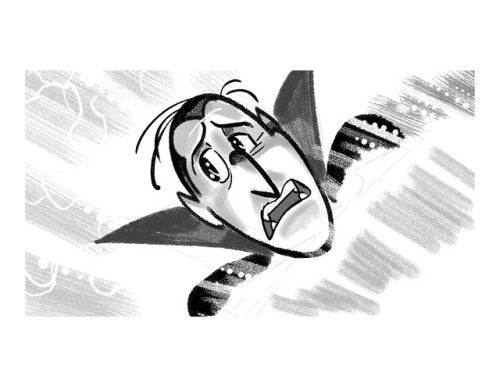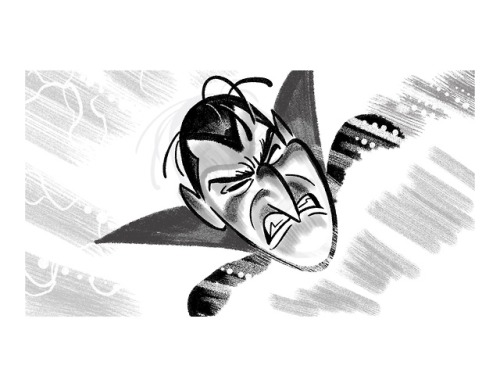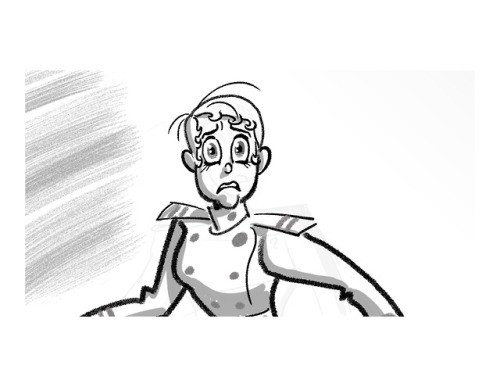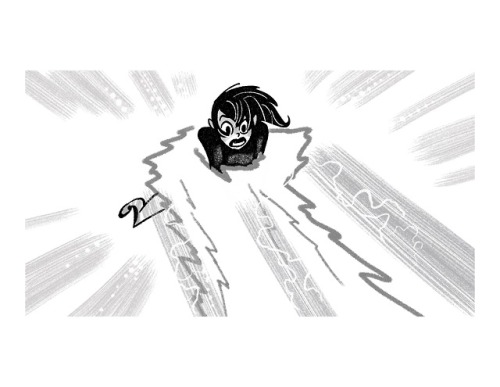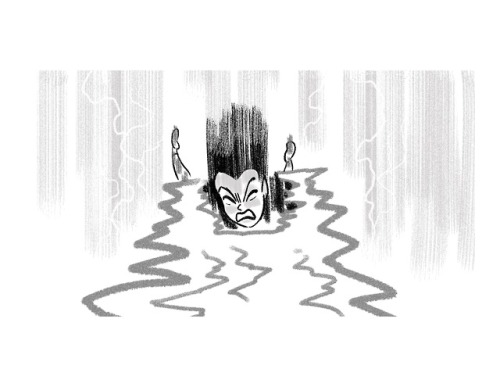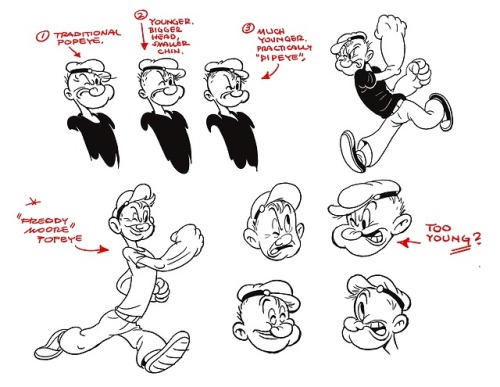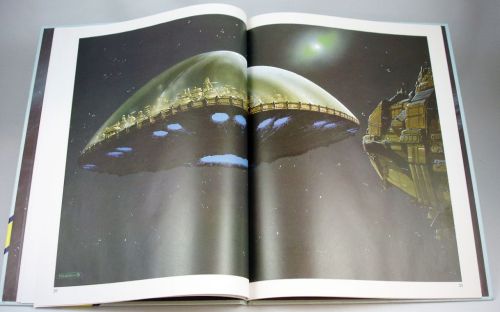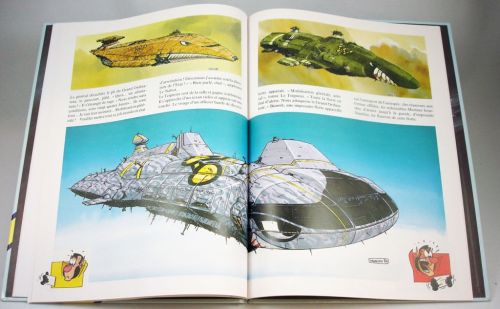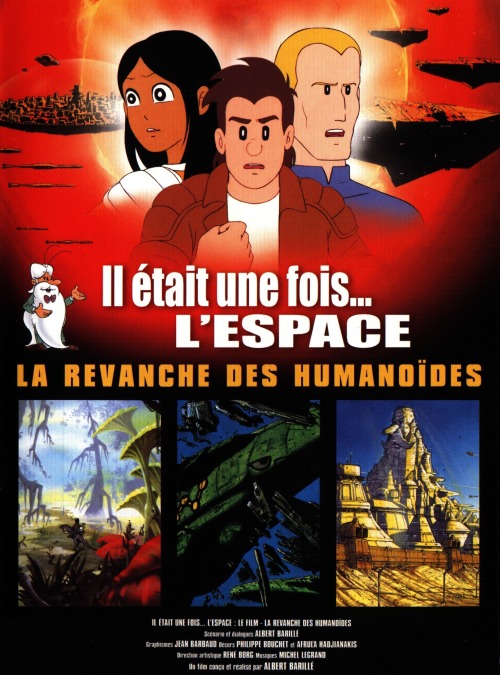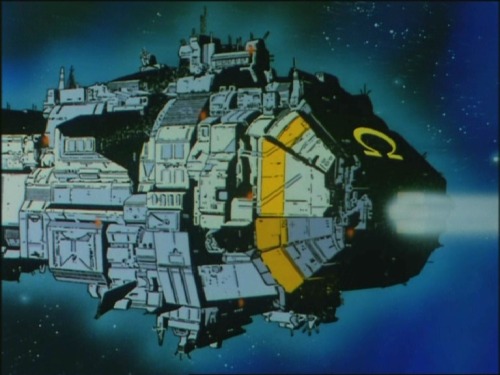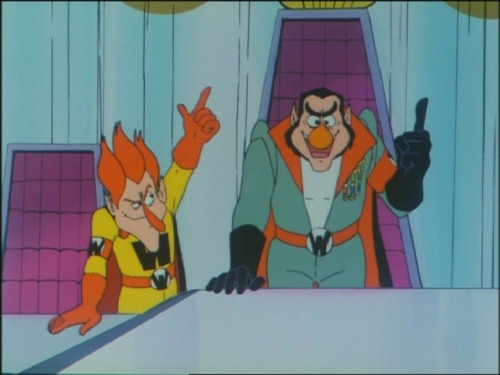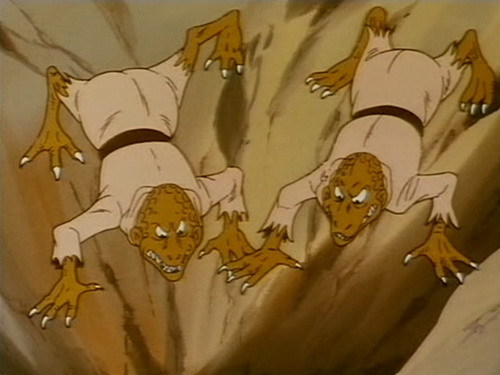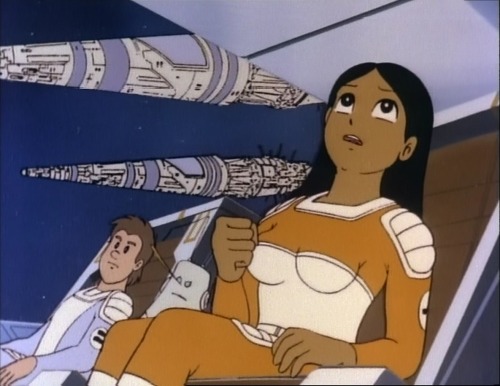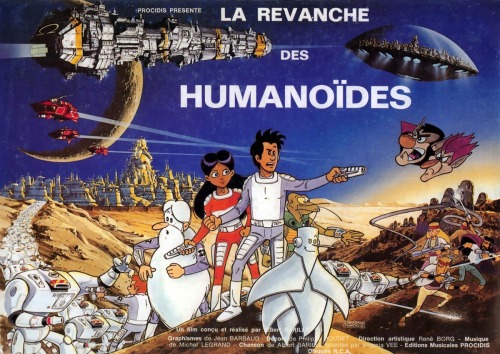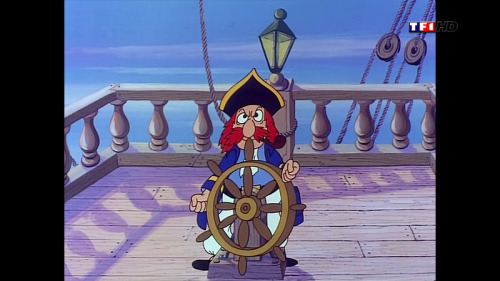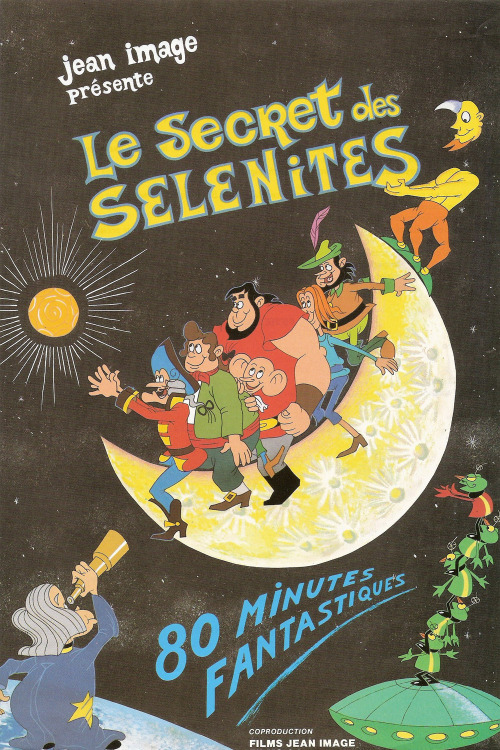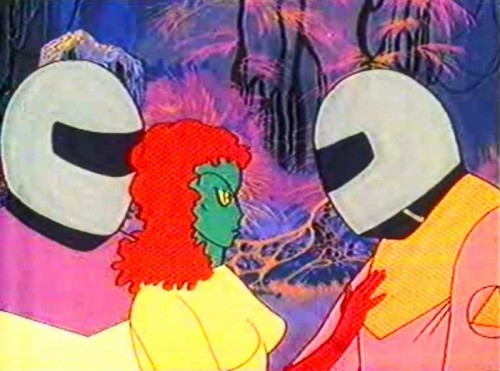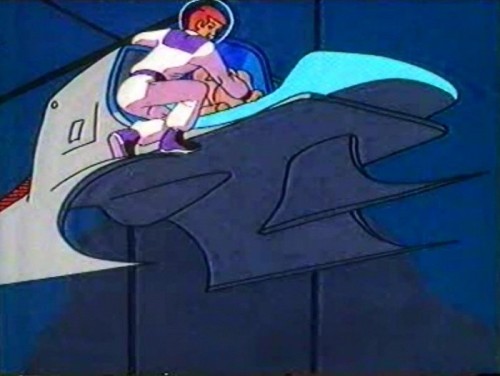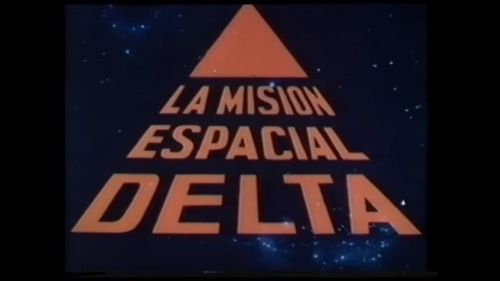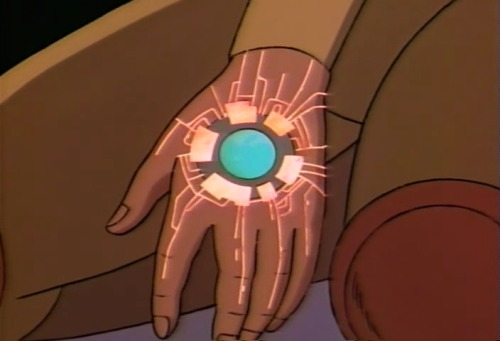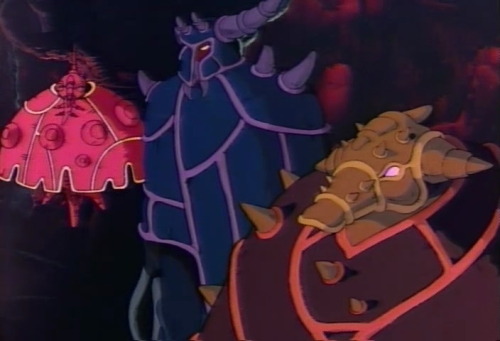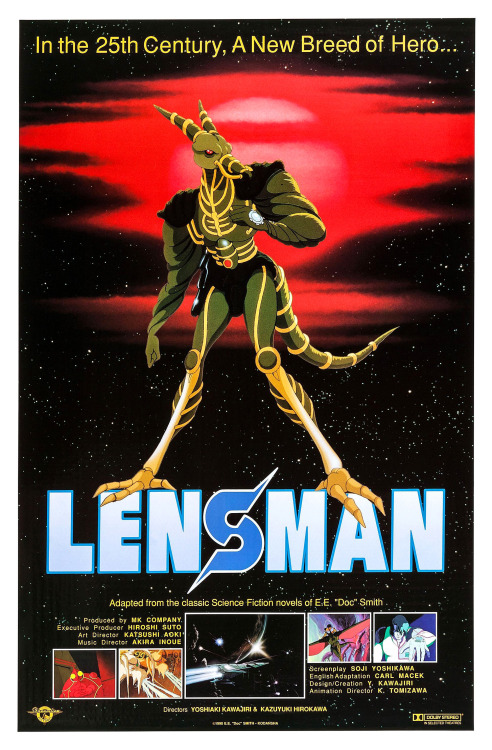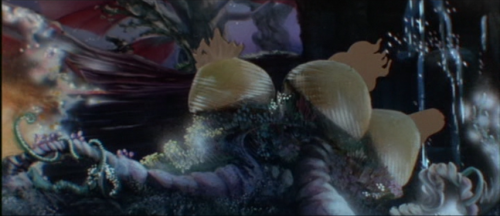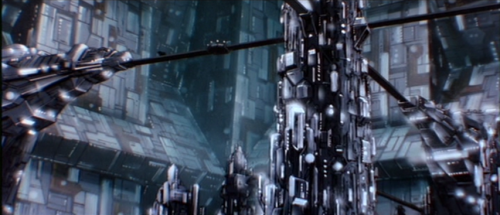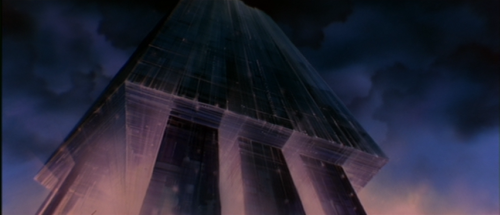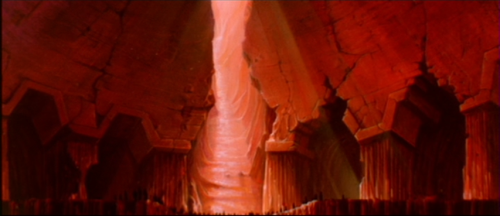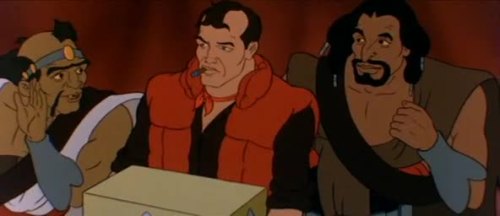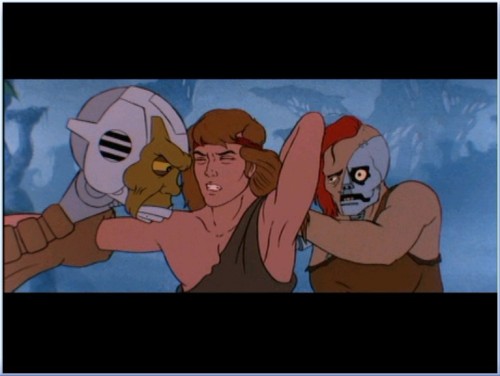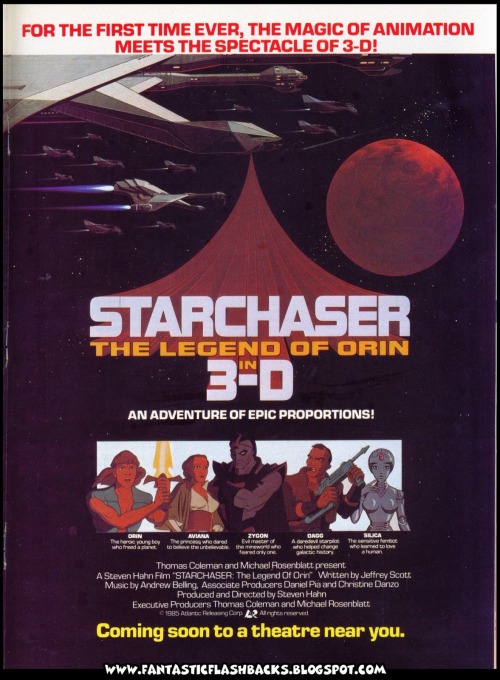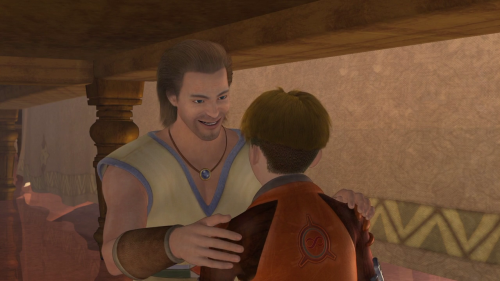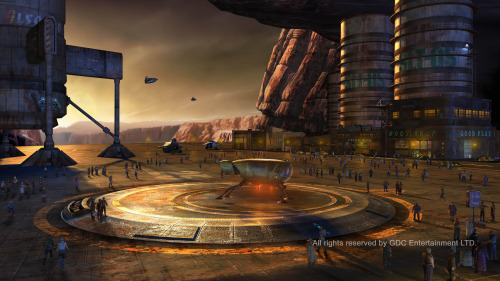#animated feature
Released in French theaters in 1983, Revenge of the Humanoids recaps the story arc of the best episodes of the French/Japanese animated science fiction/space opera television series Once Upon a Time… Space — the final six episodes out of 26 — through a condensed 100 minute long montage feature film.
Synopsis: On the way back from a routine mission, a vessel of the Galaxy Patrol, commanded by Lieutenant Pierrot, his assistant Psi, and their robot Métro, witnesses a strange phenomenon in space: monstrous ships flocking together in order to carry out gunfire exercises. The extent of the power is huge! But when the heroes decide to report it to the Omega Confederation, their ship is caught in turbulence. They then crash on a hostile primitive nearby planet. Psi is captured by humanoid robots and made a prisoner on the neighboring planet Yama, while Pierrot is saved by a group of men who live secretly in the mountains of this planet, Apis. The mountain men help Pierrot find a new spaceship on Apis and escape to Yama. Here, they must face the master of the planet and its humanoid inhabitants, the Great Computer. Several centuries ago, this computer was programmed to dominate the universe. The destruction will now begin… unless Pierrot can stop it in time!
The first two images above come from inside the book La Revanche Des Humanoïdes: De nouvelles aventures de Pierrot, Psi, Métro et Maestro… D'après le film d'Albert Barillé (English Title: Revenge of the Humanoids: New adventures of Pierrot, Psi, Métro and Maestro… From the Albert Barilléfilm) published by Sogemo in 1983 (ISBN: 2-904310-06-1). Philippe Bouchet aka ‘Manchu’ drew the spaceships and mech.
The third image above is a character art of Pierrot, Psi, and Métro found on the back cover of this book.
The fourth image is the French DVD case cover art.
The fifth image is from a series of promotional images released by the movie’s theatrical distributor, PlanFilm.
Post link
Title:Revenge of the Humanoids/La Revanche Des Humanoïdes
Release Year: 1983
Production Countries: France, Japan
Film Director: Albert Barillé
Art Director: René Borg
Length:100 Minutes
Synopsis: Lieutenant Pierrot and his girlfriend & co-pilot of the vessel Libellule are on their way back to their home planet Omega with their positronic brain android Métro. This trio are the most successful team on the Galactic Patrol, the space police force for the Omega Confederation, a peaceful alliance of planets led by Pierrot’s mother, President Pierrette. What should have been a routine patrol mission turns disastrous as the three heroes unwittingly fly into space occupied by the Omega Confederation’s enemy, the Republic of Cassiopeia. They discover the Cassiopeian army ships are testing a powerful new weapon with a force capable of disintegrating a planet! The Libellule catches some reverberations from the energy blast and is sent off-course, crash-landing on the nearly-unknown primitive planet of Apis.
On Apis, a partially-injured Pierrot is rescued by an underground rebel group of humans living hidden in the mountain who are at war with the hostile surface Native tribe. These rebels are also fighting against the dictatorship of robots that exist on the nearby planet Yama. They help Pierrot find a working spaceship and escape Apis, reaching Yama.
Pierrot reunites with his android Métro on Yama and with the rebels penetrates obstacles en route to the central city where Psi is being held prisoner by the humanoids. While the leaders of the Republic of Cassiopeia, General The Pest and his lackey, The Dwarf, believe Yama is their ally — the planet, inhabited entirely by humanoid robots, is under control of a supercomputer. The grand computer has plans of its own not expected by the Republic of Cassiopeia — to go rogue and take control of Omega, followed by Earth. Pierrot destroys the circuit of the computer before it completes its once imagined domination of the galaxy.
This 1983 French/Japanese feature-length animated film was created by editing and reassembling the final six episodes of the television series Il était une fois… l'Espace (English:Once Upon a Time… Space), a co-production of Procidis Studio in France and Eiken Studio in Japan. The series premiered between 1982 and 1983 on French television. The final six episodes were fashioned as a mini-series and were of higher production quality than the rest of the series both in terms of story and animation. The entire series was 26 episodes at 26 minutes each. The mini-series grand finale was modified into a feature-length film of approximately 100 minutes in length.
The six episodes that were compiled and condensed into the film originally aired between February and April 1983 in France. However, the film was released in French theaters in January 1983, a month before the series wrapped-up. The film was intended to stand alone as its own comprehensible story, without significant prior knowledge of the series to understand the plot.
Post link
Title:Revenge of the Humanoids/La Revanche Des Humanoïdes
Release Year: 1983
Production Countries: France, Japan
Film Director: Albert Barillé
Art Director: René Borg
Length:100 Minutes
Synopsis:
Around the year 3000, Pierrot, his girlfriend Psi, and their android Métro (who has a positronic brain), inhabitants of the planet Omega, are tasked with ensuing space security as members of the Galaxy Patrol. The Galaxy Patrol is the police force of the Omega Confederation, an alliance of planets, including Earth. The Omega Confederation is run by Lieutenant Pierrot’s parents, his mother President Pierrette and his father Colonel Pierre. The chief enemy of the Galatic Confederation is the militant Republic of Cassiopeia, led by General The Pest and his henchman The Dwarf.
On their way back from what should have merely been a routine space travel mission, Pierrot, Psi, and Métro, the best team occupied by the Galactic Patrol, intercept a strange phenomenon in space: giant Cassiopeian ships flocking to carry out shooting exercises. The firepower deployed by these military maneuvers is gigantic, the extended range is huge — capable of obliterating entire planets! They stop to observe the military tests, and in the process of these three heroes reporting their encounter to the Omega Confederation, their vessel the Libellule is shaken-up by the turbulence of the energy blasts, and crash lands on the primitive planet of Apis.
Half-hurt, Pierrot is collected and saved by the inhabitants of this planet, a group of men who live secretly in the mountains. These inhabitants are extremely anxious because they fear the humanoid robots of Yama, a nearby planet controlled by a supercomputer that is determined to conquer the universe. These underground rebels are also fighting the hostile native peoples on the surface of Apis.
Psi is captured by the humanoids and taken as their prisoner to the neighboring planet Yama. As for Métro, he has disappeared.
With help from those who saved him, Pierrot arrives on Yama to rescue Psi. Along the way he finds Métro underground and it is with his android friend that Pierrot tries to penetrate to the center of the secret city where Psi is being held hostage. Aided by a few of the rebels, they manage to cross the dams and roadblocks and reach the heart of the city. They release Psi and then are faced with the large computer long-ago designed to govern the whole of Earth.
They then learn that their planet, Omega, is the next goal of the grand supercomputer and all must comply. While Omega are preparing for confrontation, Pierrot succeeds in approaching the computer and destroying its circuits before the computer successfully took control of its target planet.
______________________________________________________________
Il était une fois… l'Espace (English:Once Upon a Time… Space) was a French and Japanese co-produced science fiction/space opera television series which first aired on television in France between 1982 and 1983, and on TV in Japan in 1984 as Ginga Patrol PJ(English:Galaxy Patrol PJ). It was written and directed by Albert Barillé with artistic direction by René Borg.
La Revanche Des Humanoïdes (English: Revenge of the Humanoids) is a compilation/condensation of episodes #21 through #26 — the final six episodes of the 26-episode series. The individual episodes were around 26 minutes in length each, and the feature film edit is approximately 100 minutes in length.
According to the art director, René Borg, the film Revenge of the Humanoids was released in French theaters in January 1983, a month before the broadcast of the six-part mini-series finale to Once Upon a Time… Space premiered on French television in February 1983.
The film has a feminist message as the supreme leader of the heroic, democratically elected government the Omega Confederation, is a female President, and Psi, a female space police member, is the co-protagonist.
Post link
Title:
English: Revenge of the Humanoids
French:La Revanche Des Humanoïdes
Release Year: 1983
Production Countries: France, Japan
Film Director: Albert Barillé
Art Director: René Borg
Animation/Production Studios: Procidis, Eiken
Medium: hand-drawn animation
Genre: sci-fi, space opera
Length: 100 minutes
Title:The Secret of the Selenites/Le secret des Sélénites
A French feature-length animated film by Jean Image
Released in 1984
76 Minutes Long
In the depths of the moon lives a mysterious people, the Selenites, who have the ability to live eternally thanks to an invaluable talisman. Baron Munchausen, accompanied by his faithful friends with strange abilities, take off on board a sumptuous boat to the moon in search of the gift immortality.
Post link
Title:The Secret of the Selenites/Le secret des Sélénites
Release Year: 1984
Production Country: France
Film Director: Jean Image
Length:76 Minutes
The film begins in 1787. Baron Munchausen’s Uncle Sirius, an astronomer, stimulates the adventurousness of his nephew. Sirius says that on the moon should live the Selenites, who know the secret of immortality. On a ship upgraded with hot air balloons, Munchausen travels with his friends to the moon and meets not only the friendly Selenites, but also a hostile alien race who also claim the secret of immortality for themselves. Finally, the Baron learns the secret of the Selenites.
Post link
Title:The Secret of the Selenites / Le secret des Sélénites
Release Year: 1984
Production Country: France
Film Director: Jean Image
Length:76 Minutes
Synopsis:
The film follows the adventures of Baron Munchausen, who is prompted to travel to the moon by his Uncle Sirius, an astrologer convinced that it is inhabited by an ancient race called the Selenites. The Selentites incidentally possess the secret of immortality. The Baron takes up his cousin’s offer and travels to the moon using a tall masted ship pulled by three hot air balloons and he is aided by his super-ability friends. When they reach the moon, they are initially placed in jeopardy as their craft lands in a crater and they fall into a subterranean sea inhabited by monsters; however, the Selentites come to rescue them and take them back to their kingdom where they meet the King and Queen of the moon. However, while he is there with his friends, the moon is invaded by the Green Meanies, led by the ostentatious Trivert, who will stop at nothing to get the talisman of eternal life for themselves. They manage to defeat the meanies and they are awarded the talisman for themselves and for Sirius — and they gain the secret of eternal life. The film ends with the Baron and Sirius at the end of the 20th Century, in a futuristic world inhabited by flying cars and skyscrapers reminiscing on their adventures.
Post link
Title:
English:The Secret of the Selenites
French:Le secret des Sélénites
AKA: Moon Madness/Moontrek
Release Year: 1984
Production Country: France
Film Director: Jean Image
Animation/Production Studios: Films Jean Image
Medium: hand-drawn animation
Genre: fantasy, adventure
Length: 76 minutes
Title:
English:Delta Space Mission
Romanian:Misiunea Spatiala Delta
French:La Mission Spatiale Delta
Spanish:Mision Especial Delta
Release Year: 1984
Production Country: Romania
Medium: hand-drawn animation
Genre: sci-fi, space opera
Length:67 minutes
Post link
English:Delta Space Mission
Romanian:Misiunea Spatiala Delta
French:La Mission Spatiale Delta
Spanish: Mision Especial Delta
Released In 1984
67 Minutes Long
This is the first feature-length science fiction animated film made in Romania, a sequel and continuation to a Romanian animated series of the same name directed by Victor Antonescu, with characters drawn by Călin Cazan and Mircea Toia.
Post link
English:Delta Space Mission
Romanian:Misiunea Spatiala Delta
French:La Mission Spatiale Delta
Spanish:Mision Especial Delta
This is the first feature-length science fiction animated film made in Romania, a sequel and continuation to a Romanian animated series of the same name directed by Victor Antonescu, with characters drawn by Călin Cazan and Mircea Toia.
Synopsis:
The year is 3084, man settled interplanetary space, but space is still full of secrets… On a research mission to a newly discovered Galaxy heads the most advanced spaceship, Delta, operated by an extremely powerful electronic brain. Project Delta was conceived in order to establish a dialogue between intergalactic civilizations. Soon after an alien journalist, Alma, was allowed to board the spaceship, she and the captain noticed that the super-brain that controlled the ship could act by itself. No one, however, counts on the fact that this artificial super intelligence will want to explore the area of human emotions and feelings. Eventually, they realize that the journalist’s beauty was the reason for the brain’s odd behavior. She became its muse. The enamored machine becomes out of control and threatens all living things around them.
Directed By: Călin Cazan, Mircea Toia
Country: Romania
Year:1984
Running Time: 67 minutes
Post link
Lensman·A Japanese feature-length animated film
Released in 1984
Running Time: 107 Minutes· Directed By: Yoshiaki Kawajiri & Kazuyuki Hirokawa
Lensman took four years and $10 million to make.
SF Shinseiki Lensman was released in Japan in 1984. Carl Macek’s company, Streamline Pictures, dubbed the movie into English and released it in America as Lensman in 1990.
Lensman is somewhat remarkable from a technical perspective, as it was the first anime movie to combine computer-generated animation with traditional cel animation. The movie is above-par from a technical perspective for an anime of the period.
The movie is very loosely based on Galactic Patrol by E. E. “Doc” Smith.
Based on the seminal space opera stories by E.E. Smith that eventually inspired Star Wars, the feature film directorial debut by the famed Yoshiaki Kawajiri, and one of the earliest anime movies to combine computer animation with hand-drawn cels,Lensman certainly has pedigree.
Post link
Lensman / SF Shinseiki · A Japanese production
Japan Release Year: 1984
U.S. Release Year: 1990
Based on the classic science fiction novel Galactic Patrol by E. E. “Doc” Smith
Running Time: 107 Minutes· Directed By: Yoshiaki Kawajiri & Kazuyuki Hirokawa
This was the first anime film to use CGI animation along with traditional hand-drawn animation.
The bulk of the film was created in the traditional cel-oriented fashion (which some CG animators would call 2D) but the directors wanted some 3D/CG elements to give the film a new look. Allegedly the only feature film that had used this technology before was Tron.
Co-director Yoshiaki Kawajiri later became one of the most respected names in anime, directing notable films including Wicked City (1987),Demon City Shinjuku(1988),Ninja Scroll(1993),Vampire Hunter D: Bloodlust(2000),Highlander: The Search for Vengeance (2007) and a director of episodes in the anthology films Neo-Tokyo (1987) and The Animatrix(2003).
Reviews:
“…There are some sharp visual effects here, a combination of imaginative and innovative computer animation and the traditional hand-drawn animation, and when the special effects take over the film seems to come alive.” —Chris Hicks, Deseret News
“Adapted from the best-selling science fiction novels of E.E. ‘Doc’ Smith, this superbly animated film combines detailed hand-drawn animation with state-of-the-art computer graphics.” —Ken Innes, Absolute Anime
“The sense of cosmic scale that Smith specialized in is something that Japanese animation does like nobody else… (This was interestingly the first anime film to feature computer animation…) The action is exciting, particularly the speeder-bike chases near the end or the escape from the Overlords stronghold. The filmmakers design a fabulous array of ships — the Boskonian fleet are black clouds lit up from inside with lights, or their planetary patrol ships that are like hollowed-out animal skulls drooping with pink innards.” —Richard Scheib, The Science Fiction, Horror and Fantasy Film Review
“An excellent example of its genre, Lensman will delight the growing ranks of Japanese cartoon fans in the United States. The storytelling and character development are minimal by Western standards, but superior to the recent Akira; and the film offers the requisite array of jazzy effects, including explosions, ray gun battles, weird-looking aliens, rapid-fire editing and computer-generated imagery.” —Charles Solomon, Los Angeles Times
Post link
Lensman · A Japanese production
Released in 1984 · Based on the classic science fiction novel Galactic Patrol by E. E. “Doc” Smith
Running Time: 107 Minutes· Directed By: Yoshiaki Kawajiri & Kazuyuki Hirokawa
Lensman took four years and $10 million to make.
Synopsis:
In the 25th Century, Kimball Kinnison is an eager young pilot from a lonely agricultural planet called Mquie. Kim is living a peaceful life with his father as a farmer on their planet until one day when a runaway spaceship is detected moving at a high speed towards his father’s farm. The Galactic Fleet ship Britannia manned by Lensmen is fast approaching the planet Mquie with vital data about the location of the villainous Boskone Empire’s Devil Planet. As the spaceship is about to crash land in their corn field, Kim, being the excellent pilot that he is, boards the ship before it crashes and lands it himself, along with his companion, Van Buskirk.
On board the ship they find a severely injured, dying man whom with his dying words begs Kim to take something of his to the Galactic Fleet. The man has a legendary Lens — a semi-sentient crystalline device— embedded in his hand. As the Lensman is dying, he mysteriously passes on the Lens to Kim.
Kim becomes involved in a galaxywide battle between the forces of good and evil when this mysterious Lens of the Galactic Patrolman attaches itself to his wrist. It has turned Kim into a Lensman. Other than giving Kim unknown powers, it also contains vital information for the victory of the Galactic Fleet over the evil Boskone Empire. Kim must now bring the Lens to the Galactic Fleet. But this is not an easy task when Lord Helmet of the Boskone Empire is willing to use everything in his power to stop him.
Pursued by the Boskonians, Kimball, and the burly engineer Van Buskirk, along with spaceship Britannia inhabitants nurse Clarissa MacDougall, and the reptilian Lensman Worzel, undergo a dangerous journey to return the information to the Galactic Patrol.
Kim is soon zipping between planets on the spaceship Britannia, fighting the evil Boskone Empire with some help from the roaring Von Buskirk, and their other alien companions. Kim must find out the purpose of the Lens before the Boskone dynasty does.
Lensman is a visual adventure for the eyes. Watch as young Kim must survive the perils of the galaxy as the mysterious and frightening villains close in on his every move. With the Boskone secrets trapped within the powerful Lens Kim is gifted with, it is his responsibility to relay it to the Galatic Fleet before the Boskone Empire can catch him… but with their willingness to destroy entire worlds to get at him, does he even stand a chance?
Post link
Title:Lensman [Also Known As: Lensman: Secret of the Lens | Original Japanese Title: SF Shinseiki Lensman]
Release Year: 1984
Production Country: Japan
Film Directors: Yoshiaki Kawajiri, Kazuyuki Hirokawa
[Co-director Yoshiaki Kawajiri later became one of the most respected names in anime, directing notable films including Wicked City (1987),Demon City Shinjuku(1988),Ninja Scroll(1993),Vampire Hunter D: Bloodlust(2000), Highlander: The Search for Vengeance (2007) and a director of episodes in the anthology films Neo-Tokyo (1987) and The Animatrix(2003).Lensman was the first animated feature film he directed.]
Animation/Production Studios: Kodansha, MK Productions, Madhouse, Toho Company
Medium: hand drawn animation, CGI (at the time, the computer graphics it introduced were revolutionary, though they may seem a little primitive today)
Genre: sci-fi, space opera
Length: 107 minutes
Starchaser: The Legend of Orin (1985)
Starchaser: The Legend of Orin
A United States / South Korea co-production
Released in 1985
This 1985 animated sci-fi adventure film was one of the first full-length animated movies to mix hand drawn and computer generated animation. It was also the second ever animated feature film to be made and released in stereoscopic 3D.
Dick Sebast began as director in 1982 and devised the program for the 3D spaceships before Steven Hahn took over as director. The 3D ships were computer drawn onto paper, then transferred to cels which were inked just like the characters so they fit right in.
The film employed the use of computer vector-based graphics for the vehicles seen throughout that would be plotted out on paper first and then transferred to cels for the final production. The Walt Disney Animation Studio would later use this same technique for the Big Ben sequence in their 1986 animated feature film The Great Mouse Detective.
In many of the scenes, Starchaser featured the use of actual stereo pairs of hand-drawn images and computer-assisted stereography to produce true volumetric roundness that appeared as line art on screen.
Steven Hahn, Director: “I thought that science-fiction worked best when everything seemed real to the audience. That’s the best way to evoke emotion. And the cartoony style of Saturday morning animation wouldn’t have done the job. So I wanted realism as much as possible. It’s much harder to draw realistic characters, but I thought it would render a more emotional experience. And then I thought, if we can create that realistic setting in three-dimensions, it would work even better! So that’s why I decided to do it in 3D. And so, I assembled the crew, including John Sparey as a scene planner in 3D modeling.”
[Sparey worked with Ralph Bakshi on Fritz the CatandFire and Ice.]
Steven Hahn: “He worked on our graphics program for about six months. And later, Bill Kroyer joined the crew in our computer graphics area to fine tune things even further.”
[Bill Kroyer was the CGI artist on Disney’s Tron.]
Steven Hahn: “On Starchaser, we had the first computer graphics program that actually had a pen that could draw in 3D.”
Jeffrey Scott, Screenwriter: “A digital plotter.”
Steven Hahn: “It was the first time in animation!”
Jeffrey Scott: “The ship in Starchaser was created that way. Never been done before.”
Hahn hired computer visual effects artist John Sparey to work out a method to produce hand-drawn computer-assisted stereo pairs of art. After top, bottom, front, and back drawings of objects had been made on graph paper, the drawings were then encoded into a computer so that mathematical structures of the x, y, and z coordinates existed in the computer’s memory. These coordinates could then be used to create and output multiple points of view of the object.
Since the single-strip 3D 35mm film system was used for production, a two-pass system for photographing the cel art was used. One pass was made to record the 2-perf high left eye image on the film. Then a second pass was made to record the 2-perf right eye image. Each 4-perf frame with single-strip 3D contains the alternately stacked left and right eye frames.
The real unsung hero of this project was cameramen who had to do multiple passes for the 3D layers, effects, and adjust them for each eye without mistakes.
Steven Hahn: “All the spatial movements were accomplished with that program. There was no other way we could calculate it correctly.”
Steven Hahn: “We didn’t use any rotoscoping. I was working with Ralph Bakshi as a subcontractor, and he’d made films like Wizards with some rotoscoping. So I got to learn exactly what it actually does on the screen. But there’s no rotoscoping in Starchaser.”
Jeffrey Scott: “That’s what made it so much more difficult to create. Steven’s animators were hand-drawing human characters and getting them to move realistically. It’s the most difficult thing there is because we’ve all seen humans move and know exactly what they’re supposed to look like. There’s no margin for error. But we’ve never seen Porky Pig in real life, so Porky can squash and stretch himself and do all kinds of things and we never question it.”
Produced and directed by Steven Hahn with an international team of animators and technicians, Starchaserwas primarily produced with conventional line art animation using hand-drawn and hand-painted cels. This produced a planar look in 3D similar to much of the art in 3D comic books or View-Master cartoon reels.
Steven Hahn: “Basically, we’re dealing with a 2D medium of cel animation and turning it into 3D. This creates problems well beyond those found in an ordinary 3D live-action feature which employs objects that are already three-dimensional.”
Steven Hahn: “Pre-production and post-production were done here in the United States, and some key scenes in animation, as well. But most of it was animated in Korea. We constantly shipped footage back and forth. It was very difficult, because they’d animate a shot in Korea, and then send it over to the United States, and we’d view it in our screening room in 3D. Well, sometimes it worked correctly, and sometimes it didn’t! So we’d ask them to redo it and the process would continue like that, twice for each shot! Twice because our 35mm film was split across the middle. Top and bottom. Over and under.”
Jeffrey Scott: “Left eye, right eye.”
Steven Hahn: “For 3D, our cameraman would shoot an image for the top half of the film. And then we’d rewind the film and do the same shot again for the bottom half. So our 35mm frame was split horizontally, and it had the same movie on both halves, just slightly different. Sometimes we’d have an effect, like a laser or something, and we’d have to go back and forth twenty times! Because if one frame is off, the 3D just doesn’t work. In the middle of all that, I thought I was crazy. I had, probably, about five million dollars of my own money invested in the film. But the budget turned out to be closer to fourteen-million. I thought it would take six months to complete. It took three years! The execution on my part is nowhere near what I wanted to do, because of the technical difficulties and the size of the production. I had quite a number of people on staff in Korea and quite a number of people here in the United States. At one time I had almost ninety people on payroll!”
John Van Vliet and his Available Light Effects company in North Hollywood handled the two-pass photography for Starchaser.
Vliet: “The camera end of it was sort of a nightmare. The 3D was like doing two films at once because you had to do a left-eye and a right-eye version. But, by the time we finished doing some of the multiple passes it felt like four films!”
Post link
Starchaser: The Legend of Orin · A United States / South Korea co-production
Released in 1985 · Second ever 3D feature-length animated film in history
Running Time: 107 Minutes· Directed By: Steven Hahn
Jeffrey Scott, Screenwriter: “I wrote it as a live-action script. My viewpoint on Starchaser was just to write a good sci-fi epic. I had no consideration that I was writing animation. Basically, I wanted real characters in a live-action story. I pushed the envelope from a kid’s standpoint with a little sexual innuendo, but I didn’t write it just for kids.”
Jeffrey Scott: “There’s a sword-in-the-stone element to it. But you know, these are the archetypical things that are just there so that people can better identify with them. When I was developing the plot, I wasn’t looking at any of those things individually and trying to work them in. My initial concept was, what would it be like to live under ground where the ceiling was so low that you could never stand up fully? That was my first idea. What kind of existence would that be? From there, I built all the rest. How would you find your way out? Well, you’d dig something up! My favorite line in the movie is: ‘Never dig up, because up is Hell!’ So I just reversed our own, standard religious viewpoint. I didn’t set out to add any specific Bible imagery. I was just trying to tell a story. And at the climax, when the glowing figures arrive, what I was really saying was that we’re all spiritual beings. The scene where Orin heals his brother’s blindness was a similar thing. It was a way to show that there’s something going on beyond the physical realm. I admit it was a stretch. If I was to write the script today, I don’t know if I’d make his blind brother see again.”
Steven Hahn, Director: “I thought that science-fiction worked best when everything seemed real to the audience. That’s the best way to evoke emotion. And the cartoony style of Saturday morning animation wouldn’t have done the job. So I wanted realism as much as possible. It’s much harder to draw realistic characters, but I thought it would render a more emotional experience. We didn’t use any rotoscoping. There’s no rotoscoping in Starchaser.”
Jeffrey Scott: “That’s what made it so much more difficult to create. Steven’s animators were hand-drawing human characters and getting them to move realistically. It’s the most difficult thing there is because we’ve all seen humans move and know exactly what they’re supposed to look like. There was no margin for error.”
Post link
Starchaser: The Legend of Orin · A United States / South Korea co-production
Released in 1985 · Second ever 3D feature-length animated film in history
Synopsis:
Set in the deep underground Mine-World, a tribe of human workers are treated like slaves under the power of the evil overlord Zygon, whom they believe to be their god. These slave workers have lived underground for millennia mining crystals for the malevolent Zygon. They have been told for centuries that their world is the only world and any attempt to mine to the surface will only lead them to Hell. Until one day while mining, one of this band of worker-slaves, Orin, discovers and unearths the hilt of a mythical sword with powers only he can unlock and master. The sword issues a message urging Orin to journey to the surface, saying that if he can find the blade of the sword he can set his people free. Upon escaping to the surface of this planet, Trinia, he runs into the rogue smuggler Dagg and a pair of helpful droids and the Princess of Trinia, Aviana. Orin teams up with the reluctant smuggler Dagg and his ship, Starchaser, to search for the sword’s blade. Once all teamed up, they plan to return to the subterranean Mine-World to defeat Zygon and free Orin’s enslaved people.
Post link
Title:Starchaser: The Legend of Orin
Release Year: 1985
Production Country: United States, South Korea (Pre-production and post-production were done here in the United States, and some key scenes in animation, as well. But most of it was animated in Korea.)
Film Director: Steven Hahn
Animation Studios: Young Sung Production Co. Ltd., Steven Hahn Productions, Filmation
Medium: 90% hand drawn / hand-painted cel animation, 10% vector-based computer generated graphics. Starchaserwas the second 3D feature-length animated film in history. The film featured the use of actual stereo pairs of the hand drawn images, which the cameramen had to do multiple passes for the 3D layers. Since the single-strip 3D 35mm film system was used for production, a two-pass system for photographing the cel art was used. One pass was made to record the 2-perf high left eye image on the film. Then a second pass was made to record the 2-perf right eye image. Each 4-perf frame with single-strip 3D contains the alternately stacked left and right eye frames. The film was a stereoscopic 3D production, shot in 2.35:1 widescreen.
Genre: sci-fi, adventure
Length: 107 minutes
Thru the Moebius Strip (2005)
Directed By Glenn Chaika
Designed by Jean “Moebius” Giraud
Produced in France and China
Approximate Run Time: 87 minutes
Post link

